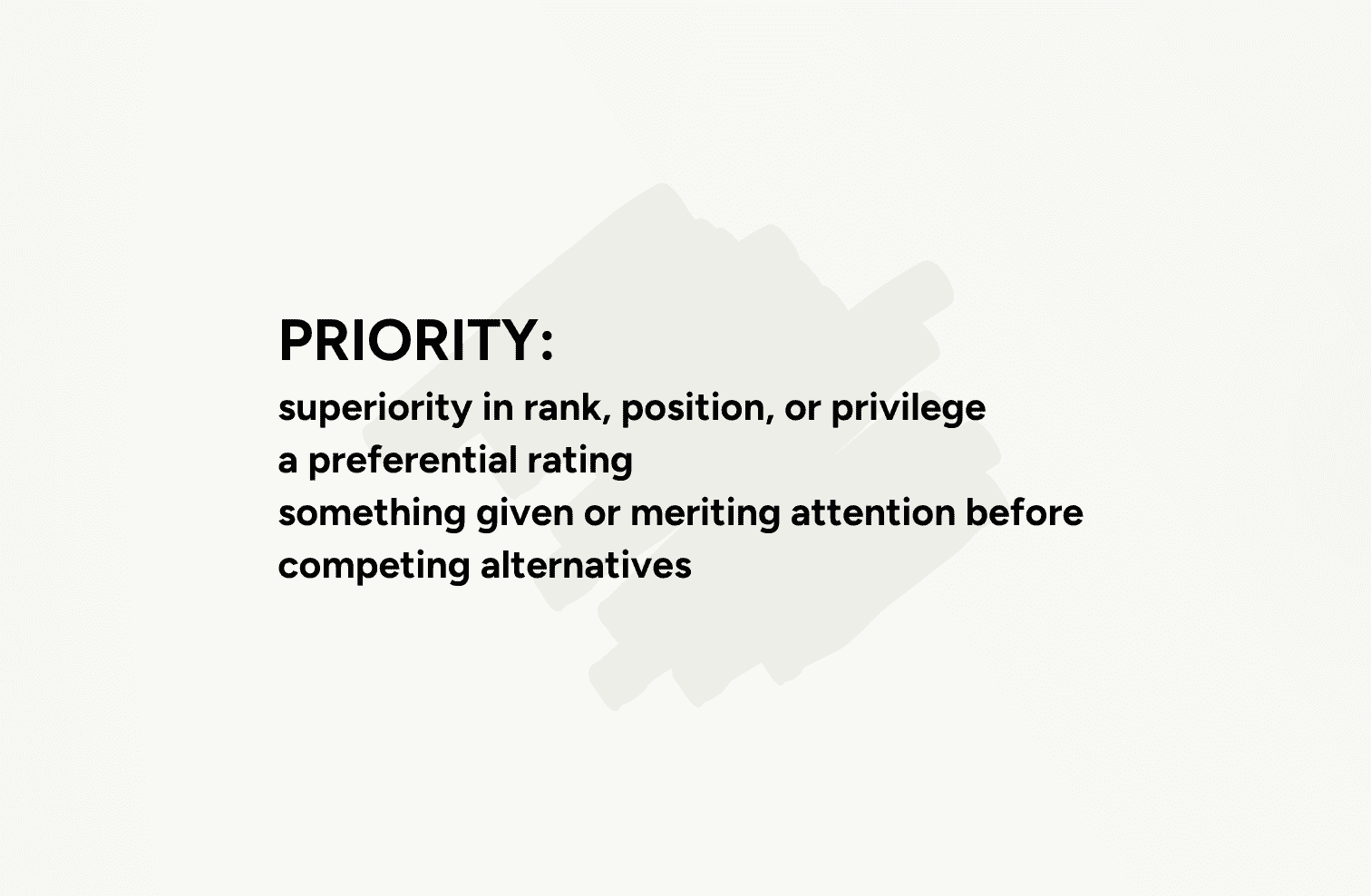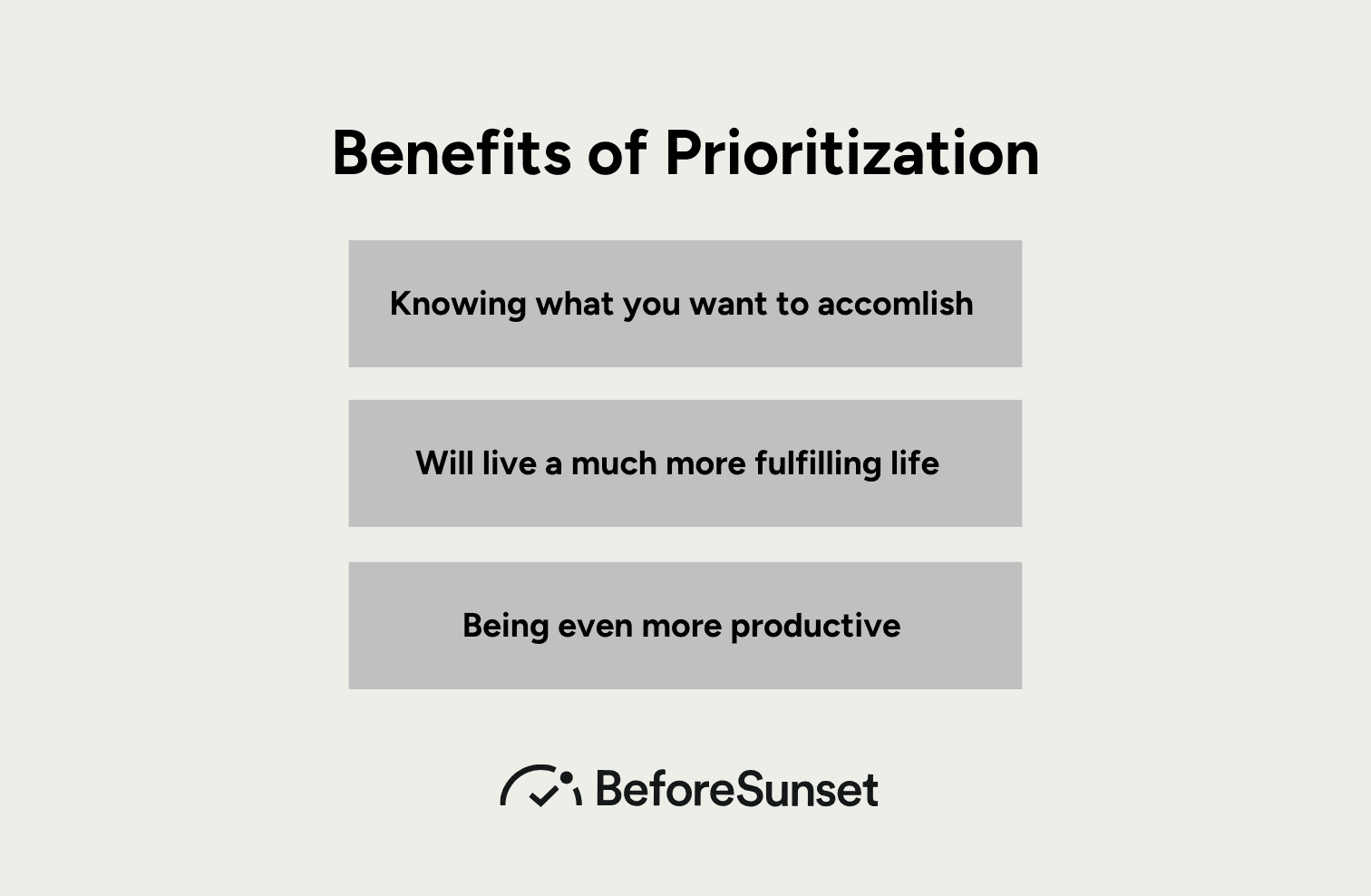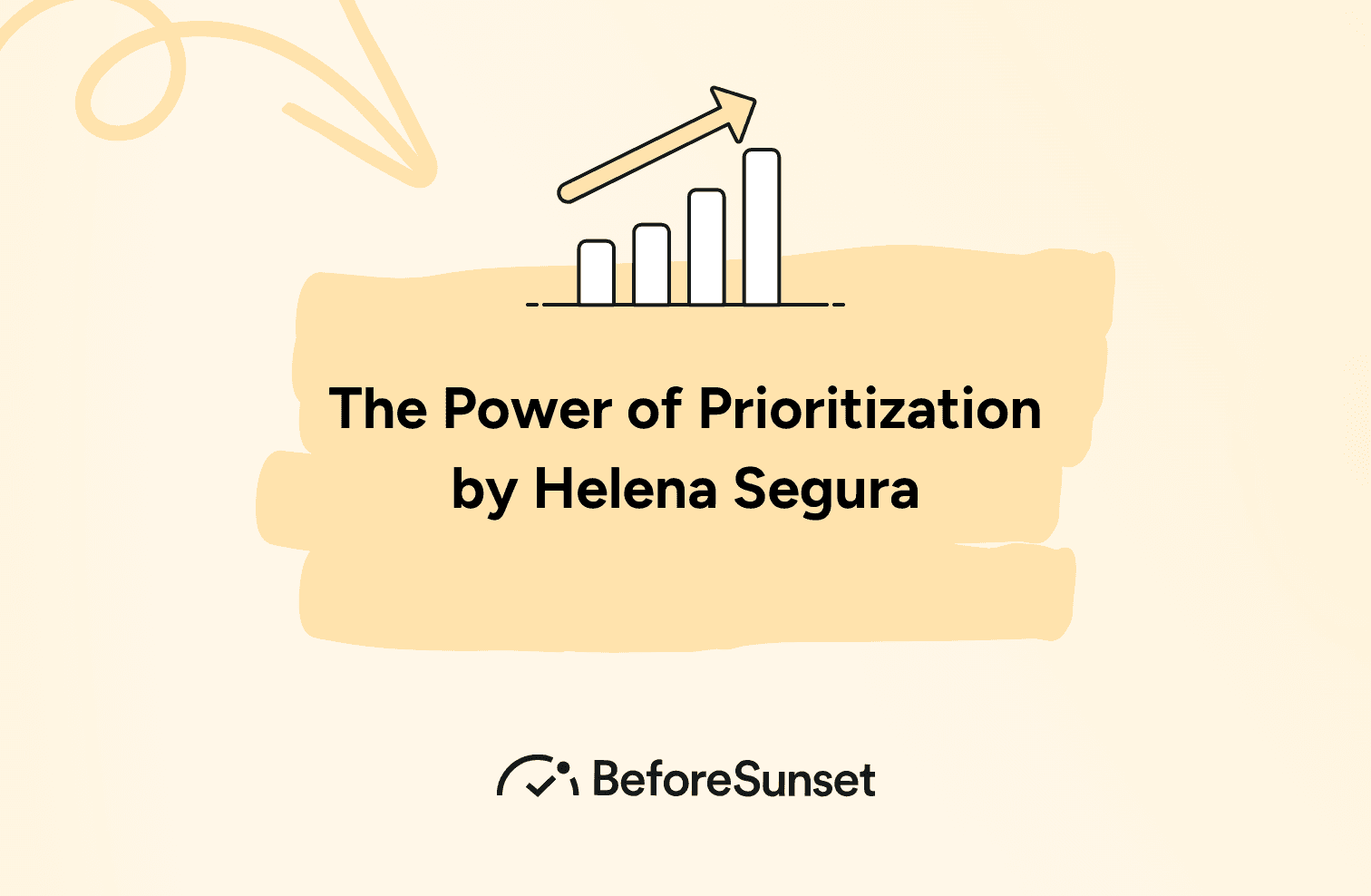If you’ve read anything about time management and productivity, you’ve probably come across the words priority and prioritization. These words are used in our everyday language and are understood by the general population. For example, you might read sports articles about how the Dallas Cowboys made it a priority to beef up the offensive line of their football team, and you didn’t need to get a dictionary to look up the word priority; you understood what was being expressed, even if you have no idea what an offensive line is.
Yet when it comes to time management, prioritization can be a difficult concept for many people to grasp and implement. If that’s the case for you, here’s some information that will help you to understand not only the importance and benefits of determining priorities but also how to identify your own priorities

The Definition of Priority
According to Merriam-Webster Dictionary, priority means:
superiority in rank, position, or privilege
a preferential rating
something given or meriting attention before competing alternatives
When you apply the word priority to time management, you're:
comparing competing pulls on or requests of your time
evaluating which pulls are of greater or lesser importance and/or of greater or lesser value
determining which pulls or requests you'll allow your time to be spent on
identifying the order in which to spend your time on these pulls/requests
Importance of Priorities
Identifying priorities is key to all decision-making regarding your use of time. Determining your overall professional and personal goals, the objectives you need to meet in order to achieve your goals, as well as what you should (priorities) or should not spend time on in order to meet your objectives will guide you in both strategic planning and situational decisions.
You have probably heard the saying that “if everything is a priority then nothing is a priority.” If our brains are unable to identify what the priority is in a situation, we tend to default to the easiest action to take – which is usually not what’s best for the situation and can include taking no action at all.
When you’ve pinpointed your priorities, this will not only help you to better focus throughout the day but will also help you re-focus more quickly if something unexpected happens and knocks you off track.
Having your list of strategic and daily priorities in front of you also helps you to respond instead of react. When we haven’t identified our priorities, we tend to be reactionary and hastily answer or work on task requests in the order they were received, which is usually not in the order of priorities.
Establishing your priorities will also help you protect your time, which is a vital component of time management.

Benefits of prioritization
As humans, we operate first based on emotions. This is why so many of us tend to operate in a reactionary manner – because we instantly want to please ourselves or others or both, or avoid negative emotions such as pain or conflict. This is how we end up completing actions that are low-hanging fruit instead of making progress toward our goals. We secondarily operate based on logic.
When we reach this higher level of reasoning, we are able to prioritize. When questions, demands, or requests come your way, if you grasp the concept of prioritization, you can progress beyond emotional and transition to logical decision-making, which allows you to make better decisions about how you use your time. You can glance at your list of strategic and daily priorities to help you triage whether or not this is something you need to respond to immediately or at a later time, or whether or not you should even be involved.
When you implement prioritization, you are crystal clear about what you want to accomplish and why. You understand the importance of comparing your options: what is more important and less important, what is of greater value and lesser value. You will tend to say yes to only the most important commitments, not allow yourself to become overscheduled, and will live a much more fulfilling, productive life, instead of just a busy one.
Additionally, when you understand the concept of prioritization, you can apply this beyond time management. This skill can benefit you in other parts of your life such as relationships and finance. When you understand how to prioritize, it means you understand how to examine different perspectives of a situation, determine what all of the options are, weigh the pros and cons of each, and determine not only what the best steps to take are in order to reach your goals, but also what will be missteps that will prevent you from reaching your objective.
You might also like:
Prioritize Your Way to Success: Unlock the Benefits of Effective Time Management
Feeling overwhelmed by a never-ending list of tasks? Struggling to manage your personal life and professional success? Mastering the process of prioritization can be your secret weapon.
Think of it like scoring high in all the "fields" of life: relationships, career, health, and personal well-being.
Effective prioritization helps you identify your biggest priorities and dedicate blocks of time to tackle them first, ensuring task on time completion. This doesn't require advanced tools or complicated strategies; even the simplest achievable steps can make a significant difference.
Prioritization isn't about avoiding tough choices. Sometimes, it means recognizing when tasks are less time-sensitive and can be delegated, rescheduled, or even eliminated altogether.
It may sound simple, but prioritization is a powerful technique that can be applied across various fields of life.
By dedicating blocks of time to your biggest priorities, you can achieve a balanced life and pave the way for professional success. Remember, it's not about completing every task; it's about strategically allocating your time and energy to maximize your impact on what matters most.
We all have the same 24 hours in a day, yet some individuals seem to accomplish significantly more. The secret weapon? Effective prioritization.
Prioritization is the process of identifying and ranking tasks based on their importance and urgency. By mastering the art of prioritization, you can unlock a plethora of benefits that extend far beyond simply completing your to-do list:
Increased Productivity and Goal Achievement: Prioritization ensures you focus your valuable time on the most urgent tasks and priority tasks that contribute directly to your term goals and strategic goals, both personally and professionally. This laser-like focus translates to task on time completion and ultimately, improved goal achievement.
Reduced Stress and Improved Mental Health: Juggling endless tasks without a clear plan can be overwhelming, leading to stress and anxiety. Effective prioritization helps you feel in control of your time and workload, alleviating stress and promoting mental health.
Enhanced Quality Time: By strategically blocking time for priority tasks and eliminating less important ones, you free up valuable time for quality time with loved ones, hobbies, and activities that bring you joy. This contributes to a more balanced and fulfilling life.
Improved Decision-Making: Prioritization strengthens your decision-making skills. By analyzing the opportunity cost of different tasks, you can make informed choices about how to allocate your time and resources, leading to better outcomes.
Enhanced Project Management: Project prioritization ensures the most time-sensitive tasks receive the necessary attention, preventing project delays and ensuring successful completion.
Taking the First Simple Step: The first step towards effective prioritization is creating a comprehensive to-do list or task list. Next, analyze each task based on its urgency and importance to your term goals.
You can also try these to prioritize your to-dos:
Utilize frameworks like the Eisenhower Matrix to categorize tasks into urgent and important, important but not urgent, urgent but not important, and not urgent and not important.
Focus on completing urgent and important tasks first, then move on to important but not urgent tasks. Delegate or eliminate remaining tasks when possible.
Prioritization isn't magic, but it's a powerful skill that can transform your time management and unlock a multitude of benefits across your work and personal life.
By embracing effective prioritization, you can achieve greater productivity, reduce stress, and ultimately, pave the way for a more successful and fulfilling life.
The Pitfalls of Poor Prioritization
Poor prioritization can have significant consequences across various time periods. Imagine a to-do list (or task list) overflowing with seemingly urgent tasks.
Without proper prioritization, you might end up tackling manageable chunks of larger tasks indiscriminately, leading to scattered efforts and incomplete projects.
This can not only harm your time management skills but also hinder your ability to achieve larger goals, potentially jeopardizing success in various aspects of life, including professional endeavors worth millions of dollars.
By prioritizing effectively, you can avoid these pitfalls and unlock the key benefits outlined earlier.
Remember, prioritizing isn't about completing every task on your list; it's about strategically allocating your time and energy to maximize your impact and achieve your most important goals.
How to Set Priorities
For determining your personal priorities, ask yourself these questions:
Who are the most important people in your life? Why?
What beliefs are most important to you to uphold and live by? Why?
What activities bring you the most joy and fulfillment? Why?
When a loved one reads a brief paragraph at your funeral about the type of person you were and what you accomplished in your life, what do you want them to say?
Based on the answers to these questions, what are your top three goals in life?
If these are your goals, what do you want to make sure you spend your time on?
If these are your goals, what do you want to make sure you don't spend your time on?
The answers to the last two questions will help you determine what your personal priorities are and are not.
For prioritizing situationally when you have so many questions, requests, and demands being made of you at the same time, ask yourself these questions:
What do you want to accomplish by the end of this week? (or this month, this quarter)
What steps/tasks will get you to your accomplishment?
Do these steps/tasks need to be completed in a particular order? Why or why not?
When will you complete these steps/tasks to achieve this accomplishment?
What are some situations/occurrences that are more important, and you're willing to give time to them this week and delay your accomplishment?
What are some situations/occurrences that are not more important than what you want to accomplish, and you're not willing to give time to them this week and delay your accomplishment?
How did you determine what is more important and what is less important?
This is the process for determining priorities and implementing prioritization. You can use priority determination and prioritization implementation to achieve your personal goals, professional goals, financial objectives, relationship goals, work-life balance goals, and time management goals.
When you can determine what is most important (and less important) to you, what you will and won’t give time to, as well as figure out what exceptions you’re willing to make and why then you understand prioritization. By implementing this powerful knowledge, you’ll be able to make the most of your time and live life on your terms.
Effective Prioritization Strategies for Limited Resources
In business and project management, particularly within investment companies and their parent companies, managing limited resources efficiently is crucial. Prioritization skills are essential to ensure that the most critical tasks are completed first, maximizing both efficiency and impact.
Prioritization Exercises and Accurate Prioritization
Engaging in prioritization exercises is a fundamental step in managing limited resources. These exercises help teams systematically identify and rank tasks or projects according to their importance and urgency. Achieving accurate prioritization during these exercises ensures that resources are directed toward initiatives that offer the most significant benefits or pose the highest risk if neglected.
Actual Prioritization Activity and Common Mistakes
During an actual prioritization activity, tasks are assessed based on criteria such as impact, effort, and risk. However, teams often make common prioritization mistakes, such as overemphasizing could-have items—tasks that are desirable but not essential—while neglecting must-have items, which are critical for achieving key objectives or preventing significant risks. Misjudging the importance of an item under consideration can lead to inefficient resource allocation and missed opportunities.
Common Prioritization Mistakes:
Focusing too much on could-have items instead of must-have items.
Misjudging the importance of tasks, leading to poor resource allocation.
Failing to consider long-term goals alongside immediate needs.
Priority Setting and Risk Priority
Effective priority setting involves a clear understanding of the organization's goals and the potential risks associated with various tasks. Risk priority is the process of evaluating the potential impact and likelihood of different issues and focusing on those that pose the greatest threat. This balanced approach ensures that urgent matters are addressed promptly, while also making steady progress toward long-term objectives.
Tips for Effective Priority Setting:
Assess the potential impact and urgency of each task.
Consider both immediate and long-term organizational goals.
Regularly review and adjust priorities based on changing circumstances.
In conclusion, investment and parent companies must implement structured prioritization strategies to manage their limited resources effectively. By avoiding common mistakes and focusing on accurate prioritization, they can ensure that their efforts are directed toward activities that provide the greatest value and minimize risks.
BeforeSunset AI: A Focus on Prioritization
BeforeSunset AI is an advanced scheduling and productivity tool designed to help teams and individuals manage their time more effectively. One of its standout features is its ability to streamline prioritization exercises, which is crucial for managing limited resources and ensuring that important tasks are completed efficiently.
Prioritization in BeforeSunset AI
The platform facilitates accurate prioritization by providing a clear overview of all tasks, categorized into must-have items and could-have items. This categorization helps users focus on critical activities, preventing the common pitfall of spending too much time on less important tasks.
Benefits of Accurate Prioritization:
Enhanced Efficiency: By focusing on must-have items, teams can ensure that crucial tasks are completed first, leading to more effective use of time and resources.
Reduced Risk: Proper prioritization helps identify and address high-risk areas early, mitigating potential issues before they escalate.
Features to Avoid Common Prioritization Mistakes
BeforeSunset AI includes tools that help users avoid common prioritization mistakes, such as misjudging the importance of an item under consideration. The platform provides data-driven insights into task urgency and importance, helping users make informed decisions.
Common Mistakes Addressed:
Overemphasizing Less Critical Tasks: The system highlights essential tasks, preventing users from getting sidetracked by less critical activities.
Neglecting Long-Term Goals: By keeping long-term objectives visible, BeforeSunset AI helps teams balance immediate needs with future planning.
Real-Time Priority Setting and Risk Management
In addition to task management, BeforeSunset AI supports priority setting by allowing teams to adjust their focus as projects evolve. This flexibility is particularly useful for investment companies and their parent companies, where priorities can shift rapidly based on market conditions.
Key Features for Priority Setting:
Dynamic Adjustments: Easily re-prioritize tasks in response to new developments or changing goals.
Risk Priority Assessment: Evaluate tasks based on their potential impact and urgency to ensure that high-risk items receive the attention they deserve.
By incorporating these features, BeforeSunset AI not only enhances productivity but also supports a balanced approach to managing both immediate tasks and long-term goals. This makes it an invaluable tool for teams looking to optimize their workflows and ensure that their efforts are always aligned with their most important objectives.

About The Author
Productivity and time management are considered soft skills, but there’s nothing soft about losing $10,000 worth of productivity per employee per year. Through seminars, on-demand videos, and individual coaching, Time Management Fixer Helene Segura reveals her mind-bending framework for decreasing interruptions, distractions, and lost time so that companies can spend more time generating profit.
The author of four books - two of which were Amazon best-sellers - Helene has been the featured organizational expert in more than 200 media interviews. Her third book, The Inefficiency Assassin: Time Management Tactics for Working Smarter, Not Longer (New World Library), and her fourth book, The Great Escape: A Vacation Planner for Busy Professionals Who Want to Take a Real Break from Work and Life (Hacienda Oaks Press), have helped thousands around the world.
To download a complimentary Productivity Kickstarter Kit, visit here.
